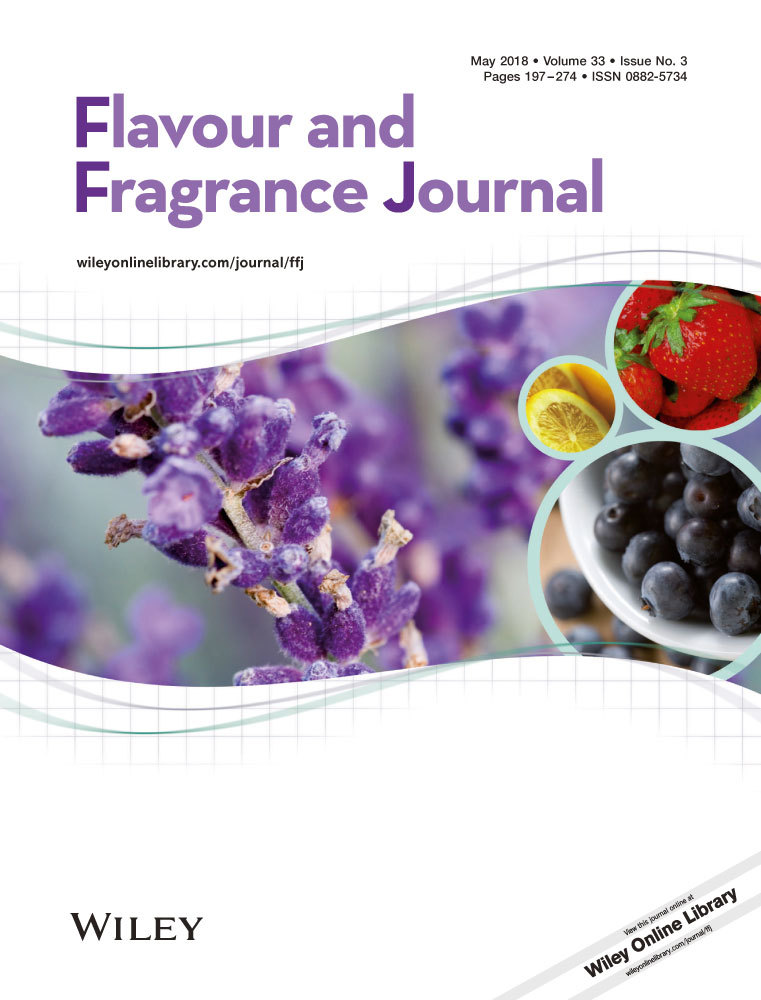Identification of flavour and fragrance constituents
Abstract
The present recommendations describe the criteria required for a publication in Flavour and Fragrance Journal to identify the volatile and non-volatile constituents of flavours, fragrances, extracts, and essential oils. Notably, the journal has adopted the ‘Statement on the identification in nature of flavouring substances’ made by the International Organization of the Flavor Industry (IOFI).1
1 GENERAL RECOMMENDATIONS
1.1 Check the authenticity of the starting material
Check the authenticity of the starting material by verifying the reliability of its sourcing (this will be detailed in a specific Technical Editorial that is currently in preparation). In the context of flavour regulation, the authenticity of the natural starting material has a specific regulatory importance, with regards to the naturalness of its constituents.
1.2 Select a sample preparation
The method used should be compatible with the starting material (i.e. one that does not induce a chemical transformation).
1.2.1 Volatile constituent identification
- If it is a known substance, two orthogonal criteria are required. Note that:
- most frequently these are gas chromatography–mass spectrometry (GC-MS) plus retention indices (RIs);
- two RIs on different column polarities are insufficient.
- For a substance discovered in nature for the first time, the authors should provide full data obtained from their own measurements, either from the isolated pure unknown substance or from both the unknown and the authentic synthetic substance (e.g. high-resolution mass spectrometry, HRMS; infrared spectroscopy, IR; nuclear magnetic resonance spectroscopy, NMR; RIs, etc.), to demonstrate its chemical structure.
- The chirality of constituents can only be specified (optical rotation (+) or (–), and/or absolute configuration (R) or (S)) if the evidence of the enantiomeric composition is reported by appropriate means, e.g. enantioselective synthesis, chiral gas chromatography, or optical rotation measurement. In the case of a commercial chiral substance, its source should be specified. The purity of synthesized materials should be experimentally assessed.
1.2.2 Non-volatile constituent identification
Liquid chromatography (LC) columns have a lower peak capacity than GC columns, and LC-MS spectra are less reproducible and usually exhibit far fewer fragments than full-scan GC-MS spectra. Therefore, special precautions must be taken. The full procedure is described in the ‘Recommended Practice’ of the IOFI, which is freely downloadable from the Flavour and Fragrance Journal website.2
- The investigated compound should be compared against an authentic substance, with both injected into the same instrument using the same settings.
- The spectrum of the unknown and reference substances should provide four ‘identification points’ (IPs), as defined by the European directive on the interpretation of results.3 Note that:
- the similarity of retention times is a prerequisite, but does not provide an IP;
- the spectra acquired using a single-dimension quadrupole MS do not provide enough IPs.
- Blank experiments should be performed before and after any positive experiment.
1.2.3 Check that the constituents identified are consistent with the starting material
- Ensure that there is no contamination of the starting material (e.g. from plasticizers used for storage or cultivation, packaging, agricultural residues, etc.).
- Ensure that there is no contamination during the sample preparation (e.g. antioxidants from the solvent used, plasticizers, thermal artefacts, solvolysis, etc.).
- Ensure that there is no chemical transformation during sample preparation.
- Any occurrence of constituents that are inconsistent with known biogenetic pathways in the investigated organism should be justified (e.g. ethylvanillin, ethylmaltol, etc.).
1.2.4 Identification in the context of a quantification method
When the objective is the quantification of an analyte in a complex mixture, and/or in the case of a multi-analyte quantification, identities should be checked in the course of the quantitative run.4
2 SPECIFIC PRECAUTIONS
2.1 Full-scan mass spectra
- The spectrum of the authentic substance, acquired by the author's laboratory.
- The spectrum of an MS database built by injecting pure authentic substances.
Collecting spectra from a mixture (e.g. essential oils) for a database is invalid because it does not ensure the purity of the spectra and the unambiguous identification of its constituents.
2.2 Retention indices
Only the RIs referring to a series of n-alkanes should be used.5, 6 The RIs should be compared with those of authentic substances injected by the authors themselves, or as follows.
- RIs from the literature must be obtained from the cited authors, and result from the injection of authentic substances. Citing papers in which the RIs from reference compounds were not experimentally measured is unacceptable.
- Tables should list both the RIs measured on the constituents of the investigated material and the corresponding reference RIs from authentic substances. The references of literature values should be indicated.
- To confirm an identification, the tolerance between the RIs of the unknown and the reference substance is 5 or 10 RI units for non-polar and polar phases, respectively. Above these values, the identification is not valid.
If comprehensive two-dimensional gas chromatography (GCxGC) is used, the RIs of the first dimension can be used as the confirmation criterion.
2.2.2 Instrumental consistency
The spectral identification and the RI measurements of investigated constituents must be obtained using the same instrument (either a GC-MS or a GCxGC-MS).
Determining these criteria on two different instruments, i.e. a GCxGC-MS and a GCxGC flame ionization detector (GCxGC-FID), is not valid for a positive identification.
2.3 Sesquiterpenes frequently have mass spectra and retention indices that do not significantly differ
These two criteria are often not sufficient for a positive identification.6 An IR or NMR spectrum might be required for confirmation.




